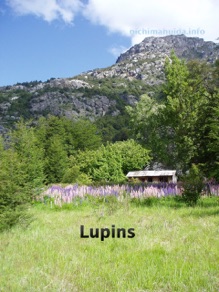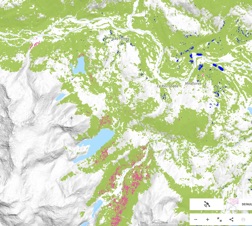
Invasive species



2012 forest loss in red


The project does not focus on “introduced” species or neophytes, as it is a novel, reconstructed ecosystem, constantly reshaped in the course of the last 100 years. The threshold and timelines between “introduced” and “native” is difficult, if not impossible, to establish, like a baseline for their control.
The main introduced species is European-origin people, leading to arrival of other “exotics”.
The term “exotic” or “introduced” usually means recent introductions. As no information exists on the ecosystem of the beginning of the XX century (pre-fires), it is difficult to certify that some “native” fauna and flora are not results of these fires and European-originated colonisation.
The damaging character of the invasiveness of some species
is greatly facilitated by the deplorable state of the ecosystem,
brutal recent annihilation of “native” species, continuous
human pressure and climate change. Invasive species thrive
where the ecosystem is devastated.
Invasive species in the project, requiring control:
Tourism industry, all aspects →
Plants. Invasive neophyte plants are one of the
main causes of biodiversity loss.
The most damaging and a major problem for the project: Rosa mosqueta (“exotic” or “native”, depending on the baseline) = Rosa rubiginosa.
It is linked to cows’ presence: in the project area where previously there were only sheep, there is no rosa mosqueta. If cows were grazing - rosa mosqueta appeared. Confirmed by work of interns from Chilean universities. Main possible entry points of cattle into the project now, and therefore threat of transport of rosa mosqueta seeds - the border with the Laguna San Rafael national park.
Considered as valuable “native Chilean rose” in Europe (see skin treatments made of rosa mosqueta). Still planted in the region for its fruit. Roots go 5 meters into the ground The way to deal with it: cut, fertilze the soil, let grass grow.
In the area: many plants are as big as trees. Sheep will eat the plants when the plants are small. Cows will not eat them, unless forced to by pressure grazing, because cows take grass etc. by their tongues and wrapping a tongue around a rose bush is not good. Sheep, goats and horses bite through the palnt with their teeth. New growth can be controlled by cutting and spraying.
Rosa mosqueta: una planta invasora que compite con la vegetación nativa | GEFEEI.pdf
Rosa_canina-eglanteria-multiflora.pdf ;
Lodgepole pine = Pinus contorta (“exotic”): planted extensively in
the region by forestry business until recently, not any longer
due to its invasive character;
The green tide that threatens Aysén?
Retamo = Ulex europaeus (partly “exotic”). Ants disperse its very
resistant, even to fire, seeds. It stifles the native flora by its density.
Its branches contain easily flammable oils which increase the risk
of fires. Models predict that this plant will continue spreading;
Calafate rastrero = Berberis empetrifolia (part of “native” cycle);
Calafate = Berberis mycrophylla (part of “native” cycle);
Chapel, meki, mata negra = Escallonia virgata
(part of “native” cycle);
Choco = Lupinus spp (“exotic”), from North America. An ecosystem engineer, can change plant populations, a legume, germinates in almost all climates, not sensitive to droughts but sensitive to frost, competitive advantage over natives under drought leading to synergetic effects and advantages under climate change,
competitive advantages as proliferates by roots as well. Can be controlled by sheep grazing only if grazed intensively, in large fields sheep avoid lupins. When ripe and dry, its fruits explode, expelling seeds at several meters around, capable of germinating after 50 years. Often used as green manure, it is therefore undesirable on poor natural sites and poor meadows, since it repels natural flora.
Insects:
Yellowjackets, wasps (“exotic”).
European bumblebee (“exotic”).
The forest of the valley seriously suffered in 2012 →
from the infestation of the cuncuna espinuda,
larval phase of the insect
Ormiscodes amphimone Fabricius (Saturniidae),
Animals:
Stray and rural owned dogs are becoming a real problem
in the region, severely damaging the local wildlife and transmitting it diseases such as mange.
The Decree 900 on “responsible pet ownership, canine species” (Decreto 900 sobre tenencia responsable de mascotas, especie canina), adopted by the Municipality of Chile Chico does not work: no administrative measures were adopted to support it.
Feral horses (introduced).
Mice (“native”) : hantavirus carrier.
Salmon, escaped from fish farms : unfit for human consumption
(antibiotic), pose human health risk, creating a sanitary crisis.
Some other invasive species like Aromo Australiano, rainbow trout,
mink, are found in the region but not in the Project.
Invasives not requiring control:
Chaura = Gaultheria Phillyreifolia and Gaultheria spp (part of “native” cycle);
Murtilla = Pernettya mucronata part of “native” cycle).
Invasive species are responsible for exorbitant economic costs
Introduced non-invasive species, not requiring control:
Horses - energize the earth, as in acupuncture, according to Rudolf Steiner's biodynamic theory, help with plant energy;
European hare - important link in the food chain of local foxes, maybe pumas.
With invasives on the menu, an endangered bird thrives | Anthropocene.pdf
Some lessons learned:
-
✴ Disturbances favor invasive plants;
-
✴ Climate change favors invasions, Le changement climatique facilite les invasions.pdf
-
✴ Plant community has not effect on invasives, to deal with the problem:
-
• clean soil from invasive material,
-
• revegetate a.s.a.p.,
-
• adapt practices to target invasives,
-
• pay attention to species under revegetation.
-
✴ Buckthorn removal lessons:
• remove when blooming,
• digging is the only option.
-
✴Removal of invasive species can lead to emergency of secondary weeds, try small plots before removing all invasives of one species, in new initiatives use only ecological parameters.
